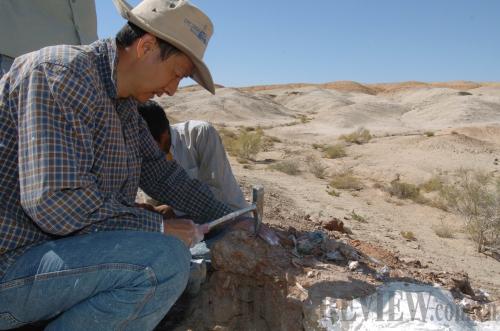|
 |
|
RENOWNED EXPERTISE: Xu Xing, a famous paleobiologist, works at the dinosaur excavation site in Wucaiwan in China's Xinjiang Uygur Autonomous Region (CFP) |
Chinese and foreign experts confirmed recently Zhucheng in east China's Shandong Province contains the biggest collection of dinosaur fossils in the world discovered to date. The fossil stratum, 500 meters long and 26 meters deep, is located in Zhucheng's Dinosaur Valley, which was formed 230 million years ago.
Dinosaurs inhabited the Earth hundreds of millions of years ago and roamed the globe for about 150 million years, yet humans were unaware of their existence until the 19th century. The word dinosaur was coined in 1842, a few years before the publication of Charles Darwin'sOn the Origin of Species. Today, much is known about dinosaurs, yet their sudden and complete extinction is still a mystery in evolutionary history.
Scientists think that dinosaurs were the most successfully evolved organisms of the period from 228 million years ago to 65 million years ago. The causes of their extinction can be best understood in the light of evolution.
"Dinosaurs are the best species to study evolution," said Xu Xing, a famous paleobiologist in the Institute of Vertebrate Paleontology and Paleoanthropology, Chinese Academy of Sciences.
Dinosaurs are studied by analyzing their fossils—the remains, traces and excreta preserved in layers of rocks. Although fossils often seem no more than bones, they carry important evidence to explain evolutionary history, Xu said.
So far paleobiologists are unable to revive dinosaurs, as people saw in the filmJurassic Park, yet they can reconstruct the creatures using scientific methods. Unearthed fossils reveal some dinosaurs had front limbs so short that they seemed to be redundant, some had long necks and some had spikes that were more like burdens than weapons. Experts believe that there is an evolutionary reason for each strange shape of the dinosaur's body, although some reasons remain unknown.
Darwin said that populations evolve through natural selection. In the 150 years since the birth of Darwin's evolution theory, the idea has been questioned. The most serious and constant challenge is the lack of "transitional fossils" between closely related species.
Some of these missing links have been found as more fossils are unearthed. In 1861, two years after the publication ofOn the Origin of Species, anArchaeopteryxfossil was discovered, bridging the gap between dinosaur and bird. In recent years, fossils of feathered dinosaurs have been found by Chinese paleobiologists, which have filled in a greater number of missing links, Xu said.
From dinosaur to bird
In 1856, Thomas Huxley, one of Darwin's fervent supporters who dubbed himself "Darwin's bulldog," attended a Christmas Eve party given by his friend, when he realized the skeleton of the turkey on the plate remarkably resembled a dinosaur's. Suddenly, a stunning hypothesis jumped into his mind: Could birds have developed from dinosaurs? |